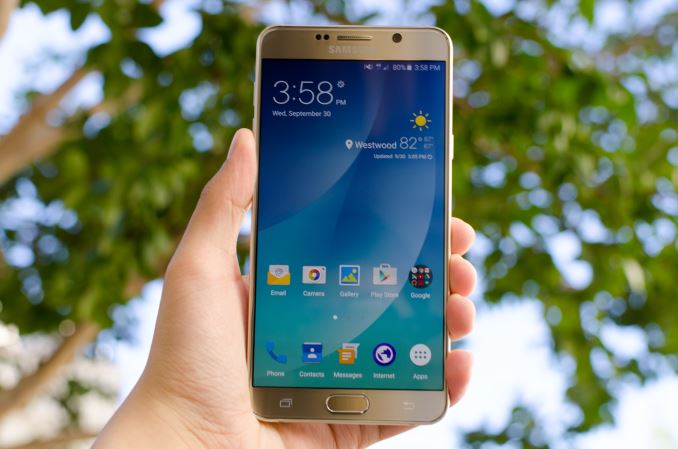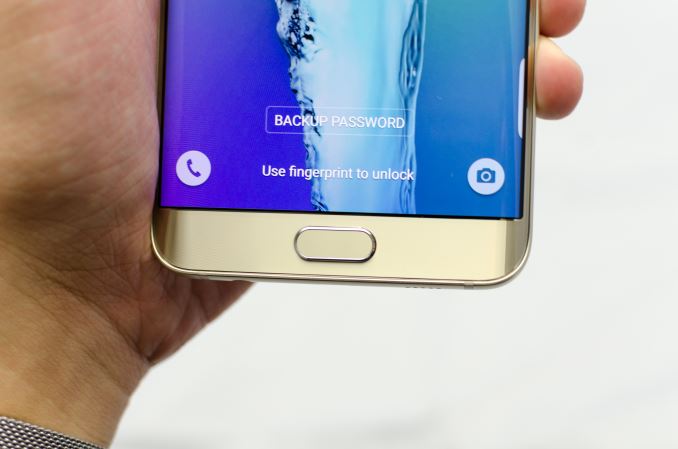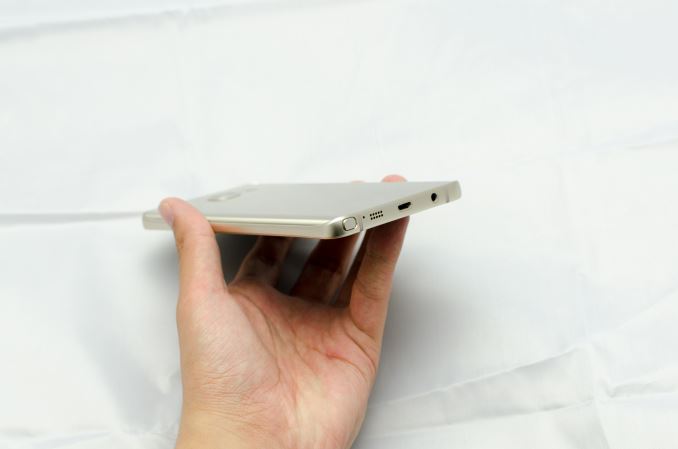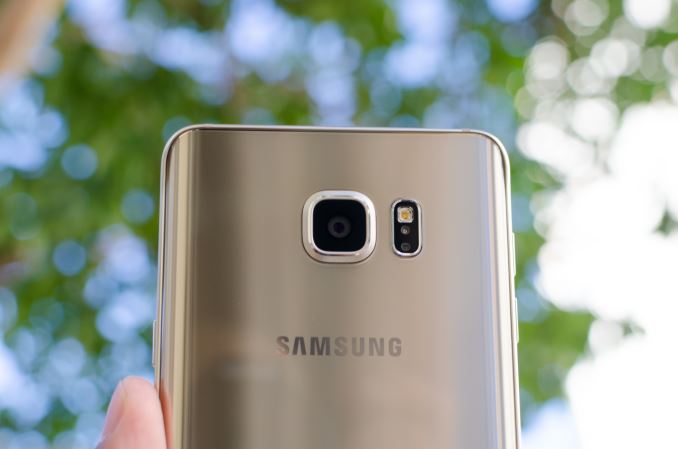The Samsung Galaxy Note5 and Galaxy S6 edge+ Review
by Joshua Ho on October 2, 2015 8:00 AM ESTFinal Words
The Galaxy Note5 is a bit of a break in form for Samsung, but in some ways it represents a return to form. To understand what this means, we can look at the various aspects that make up the Galaxy Note5 in contrast to the Galaxy S6. One of the easier places to start is the design, which shares a great deal in common with the Galaxy S6. We see a similar reflective coating under the glass, a glass back cover, an aluminum midframe, and the usual home button and thin bezels. The fingerprint scanner in the home button works about as well as you would expect and is comparable to the Galaxy S6.
The next aspect of the phone worth looking at is battery life. Here, we see that the Note5 gets a healthy bump in battery life relative to the Galaxy S6. Relative to the Note 4, battery life is basically comparable and not all that different. It seems that Samsung’s theme this year is maintaining battery life by reducing battery size and improving power efficiency. Those looking for a removable battery might be disappointed, but if you never swapped the battery in a phone like the Galaxy Note 4 there’s nothing to really worry about here. Samsung has also retained fast charging capabilities, so it isn’t nearly as important to swap batteries.
The display of the Galaxy Note5 continues to be incredible. Out of all the Android OEMs right now, Samsung is the best at display. I’m still of the opinion that the best LCDs are comparable with Samsung’s latest AMOLED panels, but within the next year or two I’m fairly confident that they won’t have any competition here. However, given the lack of second source suppliers it seems unlikely that OEMs will move en masse to OLED as strongly relying on a single supplier for any critical part of a product could easily be a disastrous mistake. The Galaxy S6 edge+ has a similar level of display quality, but the edges of the display are clearly distorted to the eye due to the subpixel arrangement used.
The SoC used continues to be the best SoC you can get in any mobile device running Android. This is likely to change next year, but given the data it’s incontrovertible that the Exynos 7420 is the fastest and most efficient SoC available in an Android device. These two factors strongly affect user experience in workloads like web browsing, updating and installing apps, and gaming. If you do any of those three things, SoC performance has a strong influence upon overall user experience for you. NAND quality isn’t quite at the same level as the Galaxy S6, but it’s more than sufficient and is unlikely to be a problem for the duration of a two year contract.
Overall, the software experience is actually quite acceptable. TouchWiz has gotten a lot better in the past generation, and any time I pick up a Galaxy S3 or Galaxy S4 I’m immediately reminded of this. However, as mentioned in the Galaxy S6 review I don’t think it’s necessarily perfect. The smoothness of the UI isn’t as amazing as some of the phones I’ve used in the past, and there are sometimes odd choices in application design like icon design. Using a Material Design theme from the theme store goes a long way to dealing with this problem, but that’s no excuse for the default theme. The Note features are useful and the single biggest reason to buy the Galaxy Note5 over another phablet, but the edge features are decidedly impractical and generally not very useful. I still think it's possible to make a better skin than TouchWiz, but I can live with TouchWiz on a primary phone.
In the camera department, on the surface nothing has changed relative to the Galaxy S6. Even if Samsung didn’t do anything for the Galaxy Note5’s camera relative to the Galaxy S6, it would still be one of the best Android cameras you can get today. However, Samsung has included a number of new features like RAW capture and improved manual mode controls. In addition, they’ve dramatically improved low light photo processing to the point that I’m confident in saying that the Galaxy Note5 beats the LG G4 and iPhone 6 Plus, but in video performance the iPhone 6 Plus is still slightly better. The Galaxy Note5 is either as good as or better than the iPhone 6 Plus for overall camera quality depending upon how strongly you want to weight video recording.
Outside of these main areas of focus, overall I like the the Galaxy Note5. In chosing to mimic the Galaxy S6 so closely it's not a bold design for Samsung and you won't find much in the way of new features, but instead what you get is in many ways a big Galaxy S6. Often because of that it's not a perfect phone - Samsung could still afford to work on polish, particularly in regards to issues like inserting the stylus backwards or RAW files that aren’t deleted - however it also does a lot well like the 5.7" SAMOLED display, the camera, and the Exynos 7420 SoC.
If you’re looking for the best Android phablet on the market today the Galaxy Note5 or Galaxy S6 edge+ is likely to be your best bet. They may not be a big jump up from the Galaxy S6, but they're still the best Android phablets you can get today. In that sense, Samsung is departing from the sort of strategy that we saw with the Galaxy Note 3 and 4 in the form of a new SoC and other improvements that came with the Note line, but like the Galaxy Note 1 and 2 these are phablet variants of their Galaxy S cousin.















225 Comments
View All Comments
Sailor23M - Saturday, October 3, 2015 - link
Well said.just4U - Wednesday, October 7, 2015 - link
While not a fanboy.. (it's a phone for (censored) sake..) I do use Samsung phones pretty much exclusively these days simply because I am familiar with them and I've yet to see a company make one I like better.. That being said.. I am a long reader and commenter here as well.. and I certainly don't see any hate-on for any company or love-in for that matter.Occasionally some reviewers may know they have a certain amount of bias for some companies and may go overboard in trying to be fair ..coming across as to critical.. but that's pretty rare.
Tech_guy - Friday, October 2, 2015 - link
Apple is designing extremely fast chips these days with amazing performance combined with iOS 9, it's hard to deny that iPhone 6s is the leader right now, by a LONG shot.nerd1 - Friday, October 2, 2015 - link
Only thing 6s is better is better singlethread performance and GPU. 7420 still has better multithread performance (which android does use, says anandtech article!) and comes with better and larger display, smaller and lighter device, and true wacom pen and better camera.I just don't get it how 6s is "the leader" as it lacks in many division compared to now old GS6.
Tech_guy - Friday, October 2, 2015 - link
It's not about the quanity of your cores but their quality. Just look at how Intel obliterates AMD because of their stronger IPC in each core. It's not of the same Apple has set the single core benchmark so high that others will HAVE to focus on single core performance. What some real world comparisons of iPhone 6s vs Note 5, anytime it's a larger app like a game or something the iPhone 6s just destroys those weak cores in the Exynos 7422.thedons1983 - Sunday, October 18, 2015 - link
What a moronic comment! If your assertion were actually true, then literally everyone would buy an iPhone. They don't, however, because not everyone wants to suck on apples tainted teat. Their software is utter garbage, and the only reason they close it down so much, is because they know that it would simply break otherwise. IOS is woeful, as is OS-x, hence why user rates are so incredibly low. Even windows 8, which lots of people hated, has user numbers that OS-X could only dream of. Primarily, it's because windows is just better. Android beats IOS in almost every respect, and the only people that can't comprehend that, are idiot fanboys like you. You are actually, and truly, pathetic.Sailor23M - Saturday, October 3, 2015 - link
I have been a regular reader since 2003/04 time period - so a good 10+ years. Although I am an Apple user I do feel the site has progressively increased their bias/tilt towards Apple. If its true that "Galaxy Phones are pushing 4 times more pixels" then this should have been mentioned in the review.Kuzi - Saturday, October 3, 2015 - link
Galaxy S6/Edge/Note 5 resolution:2560x1440= 3686400 pixels
IPhone 6/6S resolution:
1334x750= 100500 pixels
The Galaxy phones are pushing 3.68 times more pixels than iPhone 6 & 6S.
Peichen - Monday, October 5, 2015 - link
Note 5 should be compared with iPhone 6s PLUS, not the regular size one. QHD on the regular S6 is just stupid but consider Samsung cheats with the sub-pixels counts on AMOLED the smaller screen does need QHD to not show pixels.Kuzi - Tuesday, October 6, 2015 - link
Even though the Galaxy S6 uses a non standard pixel arrangment, it's 575 PPI screen is much sharper than the comparatively low res (by today's standards) 325 PPI screen of the iPhone 6S.